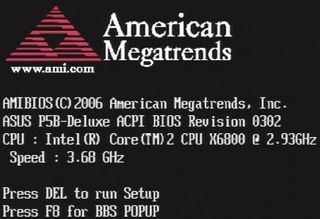THG Tuning Test: Core 2 Extreme vs. Athlon 64 FX-62
The Fastest X86 Systems Compared

One has been a star for some time now, while the other is rising to stardom. The AMD Athlon 64 FX-62 and the Intel Core 2 Extreme are ready to duke it out for honors as the fastest of all x86 systems. Let's get on with our contest, and pitch the old champion against a new one.
In this battle, performance is the only thing that counts. We'll explore the upper bounds of thermal stability for both of these top-of-the-line CPUs with standard retail components, the Intel versions of which have just hit store shelves. This occurred on July 24, the very same day that AMD introduced massive price cuts.

3.68 GHz represents the upper bound of what the Intel Core 2 Extreme X6800 can handle, remaining stable with air cooling only. The chip specification calls for 2.93 GHz.
Our testing of standard members of the Core 2 processor family has already foreshadowed what the Extreme can deliver. This time, however, it goes up against a performance-tweaked Athlon 64 FX-62 that should really be called an FX-66 or something similar. We pushed the AMD clock up to 3.05 GHz, and the memory operates at 508 MHz, though the standard speed is 400 MHz. That's 25 percent more than the wizards at AMD will officially admit.
Likewise, our test lab mavens found several ways to raise the bar on Core 2 Extreme performance. Instead of the standard clock rate of 2.93 GHz, we ran it at 3.68 GHz - this means that memory operates at 555 MHz rather than the conventional 400 MHz, a 39 percent boost. This let us put the two fastest systems for 2006 head to head so we could answer this essential question: has AMD lost the performance race to Intel? (Our newest associate didn't do too badly, incidentally, in extracting amazing performance from a tuned-up Athlon 64 FX-62.)
People who spend $1000 on just a CPU have to wonder if this is really all there is to the outlay. The answer is: not by a long shot. Heavily infected with tuning fever, the THG engineers turned themselves loose on platforms from both competitors. When they were through, both machines left more conventional offerings way behind them. Those willing to expend the time and effort on one or more of these systems will soon discover that they can have a system today that could qualify as a top performer for 2007. Whether you're a performance fetishist or a total benchmark hound, you're bound to get something worthwhile from these 2006 tests from our labs.
AMD has built overclocking protection for RAM into its new AM2 socket, which means that memory won't run faster than 400 MHz. But Nvidia SLI chipsets offer a workaround for faster memory, and enable the use of higher FSB clock speeds. In our case, we were able to boost the FSB clock rate from 200 MHz to 254 MHz and the aforementioned chipset made the necessary adjustments to permit memory speeds to increase by the same proportion.
Stay on the Cutting Edge
Join the experts who read Tom's Hardware for the inside track on enthusiast PC tech news — and have for over 25 years. We'll send breaking news and in-depth reviews of CPUs, GPUs, AI, maker hardware and more straight to your inbox.
Current page: The Fastest X86 Systems Compared
Next Page Core 2 Extreme: 3.66 GHz And FSB 1333Tom's Hardware's dedicated news crew consists of both freelancers and staff with decades of experience reporting on the latest developments in CPUs, GPUs, super computing, Raspberry Pis and more.
Most Popular


